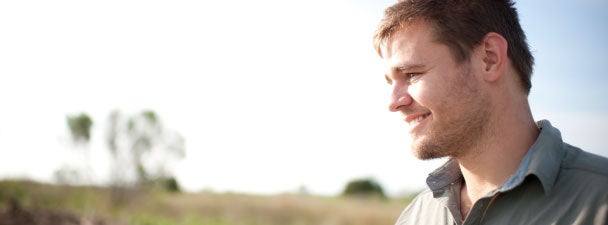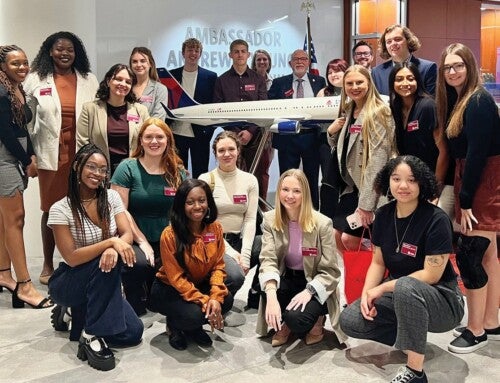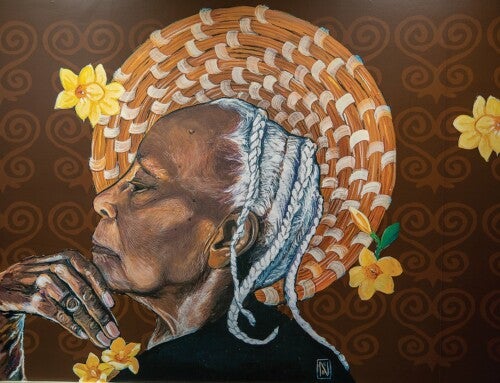Biologist. Explorer. Barefoot evangelist. Photographer. Defender of the defenseless. Self-taught filmmaker. Whatever he is, Justin Jay ’08 has a purpose, and it’s a matter of life and death.
By Mark Berry
Photography by Brennan Wesley
They are coming right toward him. Justin jay ’08 holds his breath and feels a bead of sweat slowly trickle down his cheek. Every hair on his arm seems to be standing on end. His knuckles go white gripping the handle of the knife he’s trying to soundlessly unsheathe. The knife, he knows, will do little if anything to help him, but you just never know, he thinks, and it makes him feel slightly more secure to have something, anything, in his hand to wave in the face of an oncoming attacker.
Through the narrow hole in his camouflaged hide, which he had constructed with a fishnet found on the beach and a few branches and vines cut with his knife, he watches the drill monkeys approach – the alpha male leading his troop away from a highland stream and back into the cover of the dense jungle.
Even in this moment of excruciating tension, Jay can’t help but marvel at the beauty of this endangered species. The brown, almost orange eyes set deep in a face seemingly cut from obsidian. The long, black hands tipped with human-like fingernails. The soft fur: brown, black and all the gradients in between – a perfect camouflage in this African island forest. And, of course, the bright purple and red genitalia, as if painted by some rainbow lover’s imaginative hand, standing in stark contrast to that drab coat.

Drill monkey, Bioko Island; photo by Justin Jay
Jay is not lost in his reverie long. He knows that the nearing dominant male, weighing close to 50 pounds, sports a set of long canine teeth capable of ripping open fruit, crabs and turtle eggs, and that one bite, even a glancing blow, might prove deadly. Especially when he’s a mile or so from camp and then probably another five miles from the closest village – on foot. In an effort to quell his mounting nerves, he tells himself that these primates only attack people, usually hunters, when they are provoked.
But here he sits – alone in their territory. Just a few feet away. And with just an inch or so of leaves, sticks and vines as a defensive cover. Who knows what they will do in this situation? No one has ever really been where he’s sitting. Those who get this close are usually pointing a shotgun, not a camera.
The alpha male stops and sniffs the air. Every muscle in Jay’s body is aching from holding absolutely still for what seems a lifetime. Please, wind. Don’t shift on me now, Jay pleads. The large drill monkey finally grunts and lopes past Jay’s hiding spot. The rest of the troop splits up, passing by on either side of the hide.
Jay can hear the bushes rustle behind him, and then, silence – his senses completely attuned to the drill monkeys’ departure. Eventually, the noise of the jungle returns to him: the shushing of the nearby stream, the musical clucking call of a distant turaco, the rising rhythmic hum of insects and the rushing sound of his own breath as he finally exhales.
That … was … amazing!, he thinks, almost giddy with having come so close to danger, so close to an animal he has come to respect and revere.
So, how is this guy here – 6,000 miles away from home on Equatorial Guinea’s Bioko Island? Not only that, why is he barefoot, wearing only swim trunks and crouched alone in a
hide deep in the jungle observing a rare and disappearing species of monkey?
The answer to the how is pretty straightforward. But the why isn’t quite that simple. Or, perhaps, it is.
Call of the Wild
As a kid growing up in the Lowcountry, Jay always wanted to be outside. He loved exploring the woods around his suburban home in Summerville and later in Ladson. Under each fallen tree, around every bend on a sandy trail, along the fusty marsh’s edge, there was life to be discovered, things to be found. And you didn’t need any money for it.

Jay was one of four kids of a single mom. He learned pretty quickly the limitations of a one-income household. While his friends played video games, accumulated toys that they didn’t even want to play with and watched cable TV, Jay, when not outside, found entertainment tuning into naturalist Rudy Mancke’s NatureScene on public television.
“I loved watching that show,” Jay recalls. “Even then, it looked really dated. But it was awesome to learn about South Carolina’s wildlife and different environments. Rudy was a man that could go out into the woods and tell you about life in every corner. I wanted to be able to do that.”
That desire to have an encyclopedic knowledge of the outdoors shaped almost every aspect of Jay’s childhood. He was that sunburned, dirt-smudged kid forever carting around captured frogs and lizards in his pockets. The one who could tell you the difference between loblolly and longleaf pines. The fourth-grader who caught a rattlesnake with only a stick and a bucket, bringing it home as a pet. Unlike so many of his friends and schoolmates, Jay was not a child of the Consumer Age. There’s more Walt Whitman than Walt Disney in him. He was a child of pluff mud, raccoon tracks, river birch, mosquito bites and magnolia trees.
But that wasn’t enough. He wanted to see more.
“I just had a general sense of wanting to get out,” Jay says. “I like seeing different things. I wanted to see how people lived in other places. Growing up in the lower coastal plain, I knew what these forests look like, so I wanted to know what alpine forests look like or a tundra ecosystem looks like.”
Yes, Jay was also the kind of kid who talked about forest types and ecosystems.
When Jay turned 16, he headed out West on his own. The destination was Wyoming and the general reason for the trip was a family reunion. With $300 saved up from mowing lawns and his part-time job as a bagboy at a local commissary, he told his mother he would meet the family at the reunion and off he headed west on I-26 in his bright-yellow Chevy 1500 pick-up, affectionately called Heidi.
“My mom inspired me,” says Jay about his teenage travels. “She was a rambler, too. And, despite raising four kids on her own, she finished her master’s degree when I was in sixth grade – and she was also a volunteer firefighter. Though we didn’t have a lot of money, we didn’t really need it, and I saw few limitations because of it.”
For several years, summers became Jay’s season of exploration. In the back of his truck, Jay carried tools, a bike and backpacking gear. He did odd jobs, mostly landscaping and remodeling, to earn pocket money on the road. He’d stay with far-flung relatives when he could or simply camp out in state parks or on the side of the highway. He learned pretty quickly that the best spots to camp in any given small town were in front of the courthouse or the police station – people just wouldn’t mess with you there.
But Jay also wanted to get away from people. To see places far removed from factories, strip malls and cookie-cutter housing developments.
To that end, Jay possessed a confidence in the wild, on his own, that few teenagers, few people of any age, have or ever get. When he was 17, on one of his summer meanderings, he decided to backpack alone in the Rockies. He wanted to test himself and do a solo summit.

The park rangers, shaking their heads in disbelief, warned a bright-eyed Jay about the dangers of hiking alone. Jay, who possessed an independent streak that would make even lightning look dim, was undeterred. But once in the wilderness, alone on the trail for the first time, fear did creep in.
“I have to admit I was a little afraid,” Jay laughs. “You hear stories about mountain lions and bears. But I kept going.”
And going.
By the time Jay ended up in that hide in the African jungle, he had logged countless hours of solitary pursuit in the wild. And whatever fear Jay had of things that go bump in the night had disappeared, replaced by a fascination and deep respect for how creatures live in their environments.
“Nature is not a nasty thing with teeth ready to kill you,” Jays explains. “This may sound a little macho, but there are not that many things in the forest to worry about. You operate in the environment because you’re just another animal in that environment. It’s not like it’s against you – that’s a completely modern, human idea. So, once that switch is flipped in your mind and you trust in yourself that you’ll make the right decision when you need to, you then stop worrying about everything. It may seem weird, but you come to this realization when you’re out there a lot.”
That realization was especially poignant one day in the desert outside of Las Vegas. Working for the U.S. Geological Survey’s Biological Resources Division, Jay, who graduated with a degree in biology, was studying a population of chuckwallas, a kind of desert lizard. The closest town was about 80 miles away on dirt roads, and he was hiking alone to a basalt canyon. One moment it wasn’t there, and then it was. Without breaking stride, Jay stepped over a slithering rattlesnake and kept going. No sweat.
A few minutes later, he was struck by his lack of reaction, his utter calm. And then he thought about what if he fell and got hurt in the canyon. “I told myself,” Jay remembers, “that I’ll just deal with it. I’m a human man, essentially as high on the food chain as any animal can be. You can’t live in fear of the what-ifs, but you can live with the assurance that whatever comes your way, you’ll deal with it.”
His Sole Experience
Deal with it? How do you deal with a drill monkey? You shoot it – that’s how.
If you’re a local on Equatorial Guinea’s Bioko Island, living near the territory of drill monkeys, that’s most likely your reaction to someone espousing the virtues of this endangered animal. For farmers, they’re a nuisance, eating and trampling crops. For some, they’re a boogeyman in the jungle. Vicious. Dangerous. And for many others, they’re a staple of the food culture. Simply delicious.

Bioko Island, Equatorial Guinea; photo by Justin Jay
“A lot of locals still eat bushmeat pretty regularly,” Jay points out, “although it’s most likely for special events. Think of it as their cake. Imagine a campaign in the United States where you try to get people off of cake. Monkey, like cake, has such a positive association for many of them: It’s expensive – therefore, special. And it’s this thing you go to the market to get to celebrate this good time in your life.”
Jay learned these lessons while studying another endangered species, leatherback sea turtles. That’s why he was in this Western African country in the first place – as part of a research team with the Bioko Biodiversity Protection Program. They were there studying the turtle’s population dynamics, making health assessments and working with locals on wildlife conservation issues. Each evening, they started working at 10 p.m. and would go to 3 a.m., some nights pulling data on the animals until 6:00 the next morning. Therefore, Jay had some down time during the day, and his explorer’s itch needed scratching.
He would walk the beaches, trash picking for supplies. He probably scoured 20 miles of beach to find the timbers to build a raised platform for his tent. This was a priority for Jay since he had spent nearly all of his life’s savings on camera equipment before coming to Africa. “I had all of this camera gear that I didn’t want to rot,” Jay says. “And I wanted really nice circulation in the tent.”
With his camera in hand, Jay padded into the jungle. Oh yeah, by this point, Jay had gone native, so to speak.
“It’s an Old World forest on Bioko,” Jay explains. “In the Lowcountry, however, if you walk in the woods and let everything brush up against you, you’re going to be sorry. So, the first few weeks on Bioko I was very cautious. I didn’t let anything touch me. And then I talked with the locals, and you realize it’s a very inviting forest.”
Jay accepted the forest’s invitation. He no longer wore shoes. His uniform: swim trunks. He carried a knife with him at all times – primarily for splitting firewood, cleaning fish and skinning the occasional snakes that wandered into the traps of hunters whom he had befriended.
“It’s a great feeling to stand in the middle of the forest,” Jay observes, “to feel the soil under your feet, the leaves against your skin and know that the human form in its simplest was meant to be a part of this grand existence just as much as any other animal.”

In his conversations with his research team and native Equatorial Guineans, he learned much about the island’s flora and fauna. And he was quick to take his camera into the jungle to capture the exotic and photogenic.
One of the stories that struck him was about a team of National Geographic photojournalists that had blitzed Bioko Island in 2008 in an effort to capture in images the vast array of creatures living in this setting rich in biodiversity. Despite their best efforts, one of the animals they did not photograph in the wild was the drill monkey. They were only able to take pictures of those hunted and being sold, dead and alive, in the markets of Malabo, the country’s capital.
Jay found out that the drill monkey population had declined by a third between 1986 and 2006. And he knew that time was running out on this species.
“The drill was this kind of unicorn,” Jays says. “Everybody knew about it, but no one had really seen it. The stories I would hear always sounded like this: ‘One time, three years ago, I heard one and I saw the bushes move.’ I was fascinated, learning its ecology, its endangered status, all of the threats facing it. It was so desperate. An animal no one really ever sees is about to be gone forever! So, I thought, I would like to see it while I’m here.”
Jay, his curiosity piqued and his competitive fire stoked (who wouldn’t want to take pictures of something that National Geographic failed to get?), focused his biologist’s training and his wilderness tracking skills on finding this unicorn with opposable thumbs.
Clearly, Jay was not some innocent going into the jungle. He had tracked plenty of animals, both large and small, for work and for fun. As a conservation biologist in the desert, he had trailed Gila monsters, chuckwallas and desert tortoises. In eastern North Carolina, he had been a field crew leader searching for rare marsh birds. Along the coastline, he studied loggerhead turtles. And on his own, in the Black Hills of South Dakota, he had even followed the tracks of a mountain lion to its day bed.
Jay knew he would find the drill monkey. It was just a matter of when.
No Monkey Business
I can’t believe I wasn’t there, Jay said to himself.
For weeks, Jay had been looking – and looking – trying to pinpoint a good location. He had discovered tracks and other telltale signs of drill monkey activity, such as scat, half-eaten fruit and scratched-up roots. He had found a spot along a stream with a large fig tree that he thought might be one of their habitual feeding grounds.
After working until 3 a.m., he would try to get about two hours of sleep and then hike a kilometer into the jungle in order to be there by 5 a.m., just before dawn. He would sit there, usually for five hours, waiting, listening and waiting some more.

A colleague on the leatherback turtle research team expressed interest in seeing what preoccupied Jay so much every morning. While others jogged on the beach, made crafts and pined for the comforts of home, Jay was away: a Captain Ahab mixed with a Mr. Kurtz. So, Jay drew a map in the sand and sent his friend to his favorite spot.
“He came back later and told me he saw it – a drill running into the bush,” Jay says. “I was so upset. I had been checking that river spot every day for weeks.”
Jay’s disappointment at not being the first to spot the drills did not last long. I know where they are now, he thought. Let’s go.
Jay built a blind out of an old fishing net and branches and vines cut from the jungle canopy in order to cover his scent. He situated it across the stream and down wind from the general area he thought the drills would most likely congregate.
For a week, he sat there. Just sat there. And nothing. But on one morning, a blue kingfisher landed on his blind and chirped its morning song. A very tired Jay tried to shoo it away, but it wouldn’t leave. And it wouldn’t let him drift off to sleep either. Fine, I’m up, Jay conceded. And then a few seconds later, he saw them – the drills emerging from the jungle and making their way to the stream.
He was awestruck. They were beautiful. More beautiful than he could have ever imagined. Without breaking his gaze, he lifted his camera up. Focused. And pressed the button. The click of the shutter was like a gunshot. And the drills bolted back into the jungle. What they left behind, however, was a changed Justin Jay: the moment of discovery so intense that Jay had a new purpose.
For the next few weeks, Jay spent hours in that hide, capturing video and still images of the drill monkeys in their natural habitat. Jay made no pretenses of becoming a Jane Goodall, cuddling and wrestling with these monkeys. He knew if the monkeys became comfortable with him and, by extension, other humans, that their relaxed instinct was a death sentence. To survive, the drills needed to be ever vigilant. And for him, concealment meant gathering new knowledge and accurate data of a species rarely seen in the wild.
“When I was in that hide, realizing that I was getting footage that no one had ever gotten before, I knew that this is exactly where I needed to be,” Jays says. “I knew that out of the entire world, in this particular time in my life, I needed to be right here, sitting down on this log, in this hide, in the rain. This is where I belong. There’s nothing I could do that could be more productive, that could be more fulfilling. I am doing something I should be doing.”
That clarity of purpose led Jay to establish the Drill Project, a conservation initiative aimed at conducting scientific research and providing educational resources to save the endangered drill monkeys. For the past two winters, Jay has worked in Equatorial Guinea, recording the drills in their natural habitat and networking with government officials and local leaders about this project. His first objective, in partnership with the National University of Equatorial Guinea in Malabo and Drexel University in Philadelphia, is to produce a documentary with the footage he has shot and to inform locals about this rare animal, which the International Union for Conservation of Nature has listed as “the highest conservation priority of all African primates.”

Drill monkey, Bioko Island; photo by Justin Jay
“This film is part of a whole campaign of awareness about drills,” Jay says. “It’s a film for the locals. It will be told in Spanish, the country’s official language, and narrated by native Equatorial Guineans. The country, as a whole, has little trust for international journalists and scientists, who continually bring attention to all that is wrong with the country. And there’s a lot wrong. However, they don’t need another outside voice critiquing them.
It won’t work. And for this species to be saved, we need to do what will work.”
Jay hopes to have his film ready to air in Equatorial Guinea by next fall, and already, BBC executives are talking to him about incorporating his rare footage in their own programming. And while all of this is very exciting and the prospects very promising to Jay, it doesn’t even come close to the charge he gets being out in the wild, sitting in that hide.
“It’s so intense,” Jay smiles, thinking of the five hours he would spend daily in his hide. “Your senses are heightened. You’re always alert, looking around and listening to every sound. It’s pure adrenaline when that animal finally comes in front of you – even more so when your equipment is in focus, with the right exposure and you actually get good footage.”
Therein lies the answer to why this barefooted biologist sits alone in the jungle.
For Justin Jay, who revels in the present moment and the kinetic beauty of the wilderness, life – his, yours, a monkey’s – is precious and worth saving. And believing that to his core, Jay will do everything he can to ensure that at least this one endangered species is not relegated to the past tense – that the drill monkey will not become a museum object collecting dust next to the dodo display.




